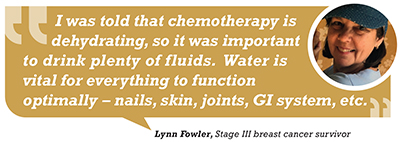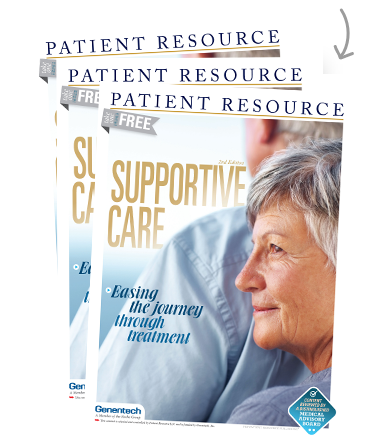Skin and Nail Reactions
Your skin and nails may change during treatment. Common skin reactions include skin redness and irritation (similar to a sunburn), skin rash, and dry, flaky skin. Common changes to your nails include changes in growth, strength or thickness, different textures or color; and lifting of the nail plate off the nail bed.
What causes skin and nail reactions?
Chemotherapy destroys rapidly dividing cancer cells, but many normal cells in your body, such as blood cells and cells in your mouth, nails, hair and skin, also divide rapidly. Chemotherapy can affect these normal cells, resulting in changes to your skin and nails.
Targeted therapy and immunotherapy can also affect skin and nails because of their effect on the normal cells near the genes, proteins or cancer cells they target.
Some drugs cause photosensitivity of the skin – an inflammation of the skin caused by the combination of sunlight and certain medications or substances – that leads to redness of the skin similar to sunburn. Skin and nail reactions are usually mild to moderate but can become severe or lead to infections if not treated early.
In addition, you may experience the following effects.
Skin reactions due to leaks: Some drugs given through a vein or artery can leak into the skin tissue. As a result, the cells in the skin tissue die. Some cause veins and tissue underneath the skin cells to become inflamed while others result in severe damage to skin, as well as ulcers and scar formation.
Excessive darkening of the skin: This may occur either over large areas or localized to smaller areas, such as under the nails, inside the mouth or along a vein where the medication was infused.
Skin growths or bumps: Unexpected growths on the skin can occur. Most are cosmetic, but your health care provider may need to remove any suspicious growths to make sure they are not a form of skin cancer.
Rashes: Those that are in a limited area, that do not cause discomfort and are not infected usually do not need to be treated. However, if the rash spreads over a larger area and causes itchiness or pain, your health care provider may prescribe a mild corticosteroid cream, antibiotic gel, oral antibiotic or oral corticosteroid.
Targeted therapy drugs can cause an acne- like rash on the face, scalp and upper trunk called acneiform rash. The rashes are not true acne; they are usually sterile and contain no bacteria. The rash is uncomfortable and can be severe enough that treatment is modified or adjusted. The pain, itching and effect on appearance can negatively impact quality of life for individuals receiving targeted treatments. Symptoms include a stinging or burning sensation, itching, irritation or pain. Topical and oral antibiotics and corticosteroids can help this kind of rash as well, but it’s important that you do not use certain medicines given to treat acne, such as a topical retinoid, because these may dry or irritate the skin even more.
Most nail changes, such as a groove across your nail plate, a thickening and/or thinning of the nail, and pale or dark streaks across your nail, are only cosmetic and will not affect your treatment. Usually, these marks reflect the times you have received chemotherapy treatments. The medication reaches the nail cells for a brief period of time, and in this period it changes the texture or color of your nail, leaving a mark that grows out with time. These nail changes are almost always temporary.
When do skin and nail reactions typically occur?
With targeted therapy, a rash most often starts within the first few weeks after taking the drug and resolves about 1 month after treatment is stopped. Nail changes may start during treatment and last throughout the duration. Nail plate issues will grow out with the nail and usually will not affect the new nail that grows in.
How you can manage skin and nail changes
If you have a history of nail changes, you may be given cold gloves and slippers (or ice packs) to wear during treatment if you are receiving certain cancer drugs. In some cases, the cold shrinks blood vessels in your hands and feet, resulting in less medication delivered to those areas.
Over-the-counter antibiotics and antiseptics may help prevent infection. Soaking your fingers and toes in a solution of 1 part white vinegar and 1 part cool tap water once a day for 15 minutes may help. If your nail problems persist, see a dermatologist.
Always wear sunscreen to protect yourself from the sun. Use a broad-spectrum sunscreen with an SPF (sun protection factor) of at least 15, and look for titanium dioxide or zinc oxide on the label. Ask your dermatologist for a recommendation.

When to call your health care provider
Report any changes to your skin or nails, as early treatment can prevent the reaction from becoming severe. If the reaction becomes painful or if you notice any signs of infection, such as fluid draining from an affected area, call your health care provider right away.
When a rash is severe, your health care provider may reduce the dose of the targeted therapy drug or temporarily stop it. Then, if the rash gets better within approximately two weeks, your provider may restart the targeted therapy drug.
If you have a skin reaction from a leak, depending on the treatment you are receiving, you may be given cold packs or heat packs to help in wound healing.
If you experience excessive skin darkening, the reaction usually disappears gradually once treatment is stopped, but if hyperpigmentation is troubling, talk with your health care provider about whether there are ways to decrease the effect.
Sunscreen use, indoors and outdoors, is always a must because even indoor lights can cause darkening.



